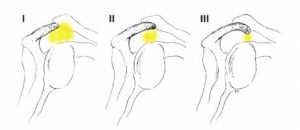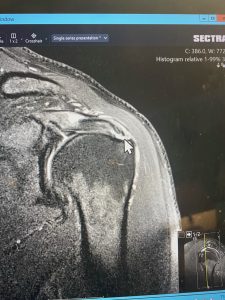The Backstory
It all began with a burning sensation in my left shoulder in November 2020 with a simple gesture. I did not give it a second thought, as it subsided in a few minutes. However, I soon began to notice more regular pain with certain movements and difficulty sleeping at night. Honestly. I thought it would subside and chalked it up to some mild rotator cuff inflammation. For years, I had avoided overhead lifts and heavy bench press, while restricting range of motion to reduce stress on my shoulders. With that said, this pain led to me further modifying my workouts.
A few weeks later, the nocturnal pain became more intense and prevalent. I knew it was time to formally rehab my shoulder. So, I did what I would advise my patients to do. I embarked on 6 weeks of rotator cuff and scapular strengthening 3x/week, while using laser, ice, and non-steroidal anti-inflammatory meds to resolve the pain. I stuck religiously to this plan from mid December to the end of February. Unfortunately, nothing helped. Sleeping was interrupted consistently, and my function was limited.
As such, I sought the counsel of a trusted surgeon I work closely with. He ordered an MRI, which revealed a 1 cm near full-thickness tear in the supraspinatus tendon, a type II acromion and a big anterolateral bone spur. As you can see from the list below, I have a borderline medium-size tear.
Rotator Cuff Tear Classification:
Small < 1 cm
Medium 1-3 cm
Large 3-5 cm
Massive > 5 cm
The picture below reveals the acromial shapes that can be found (type I is normal). The yellow area pertains to the amount of space for the rotator cuff to move within the subacromial space. A hooked, or type 3 acromion, creates the most amount of impingement. Over time, repetitive use, injury and aging can create osteophyte (spur) formation and cause friction, rubbing or attritional tears of the cuff. This is the case with me. The kicker is I am right-handed, so it is likely related to decades of weight training and sports.

Below is my MRI with the arrow pointing to the tear:

The surgeon basically told me the tear would not heal on its own, and the spur could cause more damage depending on my activities. He recommended surgery once I was ready to move forward. I got that news in early March.
Surgery vs. Rehab? This is the million dollar question to consider. Factors including tear size, tear configuration, age, quality of tissue, activity level, job requirements, pain, other co-existent pathology and disease progression/projection must be considered. There is no right or wrong answer here, but a choice must be made based on pain, function, and quality of life. In my case, rehab failed, pain at night was not subsiding, and my activity level/demand at work and in my recreational pursuits is higher and did not favor long term success with continued rehab alone. A few studies below are also relevant with patient surgical decision making:
- Limitations in shoulder function and surgeon recommendation were the most common factors influencing patients to undergo rotator cuff repair (Weekes et al. 2020)
- Patients with a full-thickness rotator cuff tear reported improvement in pain and functional outcome scores with nonoperative treatment or surgical repair. However, patients who were offered and chose rotator cuff repair reported greater improvement in outcome scores and reduced pain compared with those who chose nonoperative treatment (Ramme et al. 2019)
- 103 patients with a rotator cuff tear not exceeding 3 cm were randomly assigned to primary tendon repair or physiotherapy with optional secondary repair. Blinded follow-up was performed after 6 months and 1, 2, 5, and 10 years, with 91 patients available at the final follow-up. At 10 years, the differences in outcome between primary tendon repair and physiotherapy for small and medium-sized rotator cuff tears had increased, with better results for primary tendon repair. (Moosemayer et al. 2019)
The Decision
Given all this, I opted to have the surgery on May 20. The surgeon performed an arthroscopic rotator cuff repair, subacromial decompression, bursectomy and anterior labral debridement. My goal is to journal my recovery with my blog to aid and assist others contemplating the surgery or looking for sounds advice on how to rehabilitate this injury. I will share pictures, exercises and describe my pain level and successes and/or any setbacks with you here.
Hopefully, this point of view and perspective will be valuable for others. Moving from the PT to the patient, I will have lots to share on this topic that will help patients and clinicians alike. Stay tuned for regular blog posts to see how my recovery is going, and feel free to ask questions along the way.
References:
- Weekes DG, Campbell RE, Allegretto JR et al. A Prospective Study of Patient Factors and Decision-making for Surgical Repair of Symptomatic Full-Thickness Rotator Cuff Tears. Orthopedics. 2020 Mar 1;43(2):85-90.
- Ramme AJ, Robbins CB, Patel KA et al. Surgical Versus Nonsurgical Management of Rotator Cuff Tears: A Matched-Pair Analysis. J Bone Joint Surg Am. 2019 Oct 2;101(19):1775-1782.
- Moosemayer S, Lund G, Seldom US et al. At a 10-Year Follow-up, Tendon Repair Is Superior to Physiotherapy in the Treatment of Small and Medium-Sized Rotator Cuff Tears. J Bone Joint Surg Am. 2019 Jun 19;101(12):1050-1060.

